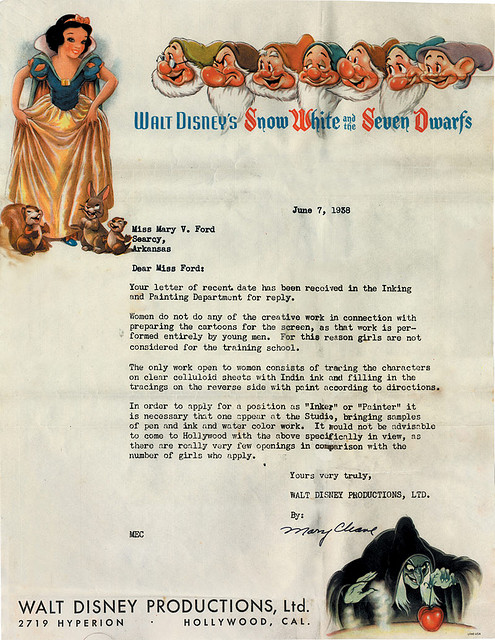Put yourself in the mind of an artistic young woman who goes to see Disney’s Snow White and the Seven Dwarfs when it first opens in 1937. Captivated by the film’s groundbreaking cel-based cinematic animation, understanding that it represents the future of the art form, you feel you should pursue a career with a studio yourself. Alas, in response to the letter of inquiry you send Disney’s way, you receive the terse rejection letter above. “Women do not do any of the creative work in connection with preparing the cartoons for the screen,” it flatly states, “as that work is performed entirely by young men. For this reason girls are not considered for the training school.” Your only remaining hope? To aim lower on the totem pole and become an “Inker” or “Painter,” but “it would not be advisable to come to Hollywood with the above specifically in view, as there are really very few openings in comparison with the number of girls who apply.”
Times have changed; women now create animation. But to catch a glimpse of the industry in decidedly pre-changed times, revisit the 1939 promotional documentary short How Walt Disney Cartoons Are Made. In it, you’ll see these very young men hard at work, as well as those “pretty girls” hired to do inking and color. Prewar Disney turned out some masterpieces, no doubt, but by today’s standards their attitudes toward gender may leave something to be desired. “This letter originally belonged to my grandmother,” writes the user who discovered the note above. “After she passed away we discovered it and were surprised at how well it was preserved for being nearly 70 years old.” Young women like her, aspiring to high places in animation, found themselves forced to find alternate routes in, although after receiving that rejection letter on that stationery — emblazoned with Snow White herself, adding insult to injury — I wouldn’t blame them for looking into other fields entirely.
via Sociological Images & Mefi
Related content:
How Walt Disney Cartoons Are Made
Donald Duck Wants You to Pay Your Taxes (1943)
Walt Disney Presents the Super Cartoon Camera (1957)
Colin Marshall hosts and produces Notebook on Cities and Culture and writes essays on literature, film, cities, Asia, and aesthetics. He’s at work on a book about Los Angeles, A Los Angeles Primer. Follow him on Twitter at @colinmarshall.



Not that it was ever acceptable for Disney to behave in such a manner. But it’s also worth keeping in mind that looking at anything with the 20–20 hindsight of current social mores is bound to make much in the past look rather bad by comparison.
The important thing is to hold what occurred as a remainder, and a warning, of what can happen if we don’t look too closely at what we consider acceptable behavior towards others.
Nowadays, there would not be such deliberate and obvious prejudice behind the rejection letter.
Instead, the little lady would be informed she is talented, and appreciated for her interest as a potential team member/artist, but the company needs have been already met. Better luck, next time!
Why bother witih correspondence from 1938? Don’t we get enough junk mail to waste time with this?
Nowadays there just wouldn’t be a reply at all (via email or any other way).
I especially love how two women anchor the letterhead at the upper left and lower right, with the cute (male) dwarves serving as comic relief, laughing at your silly ambitions.
“Put yourself in the mind of an artistic young woman who … pursue[s] a career with a studio”
The letter is also signed by a woman (it looks like Mary Cleave). Imagine being the woman tasked with squashing other women’s dreams on the basis of their shared gender.
Also, Mary Ford certainly wasn’t the only applicant who received this response: http://animationguildblog.blogspot.com/2006/06/disney-1939-girls-are-not-considered.html
Interesting! A woman rejecting another woman. Those were strange times indeed
When we get frustrated, it’s nice to look backward and remember that there has been progress — tons and tons and tons of progress.
Perhaps, the woman that is looking to hire young men for the job was also looking for a little eye candy for herself. Lol!
thats why disney went down hill, they started hiring women for artistic positions
Hey there, I’m a producer looking to hire young up and coming female animators of color for a film project, if anyone fits the bill and is looking to work somewhere that ENCOURAGES female animators to apply, holler at me, feel free to pass on my info — ch*****************@***il.com
Wow really sad…but as you can tell…at D23…female animators are very few…I wonder why…ask a fellow animator at the parks…they need to hire more women at the parks and D23. So little girls can be hopeful. And Dream that Disney Dream.
Dr. Zhivago
One of Disney’s relatively minor rivals, Walter Lantz (Woody Woodpecker, Andy Panda, Chilly Willy) employed women as animators. They were few in number, perhaps few applied; but he appreciated their talents. Foremost among them was LaVerne Harding, who became one of his top artists for roughly 20 years, and re-designed Woody in the early 1950’s. (She later worked for Hanna-Barbera, De Patie-Freleng, and Filmation.)
Others at Lantz’s included Xenia Beckwith, who went on to Warner Bros., UPA (Mr. Magoo), Larry Harmon (Bozo the Clown) and also Filmation; and Anna Osborn, who worked for Jerry Fairbanks animating lips on farm and zoo animals in his “Speaking of Animals” comedies; and later worked at Hanna-Barbera.
Max Fleischer in New York employed a couple female animators as well; Lillian Friedman and Edith Vernick.